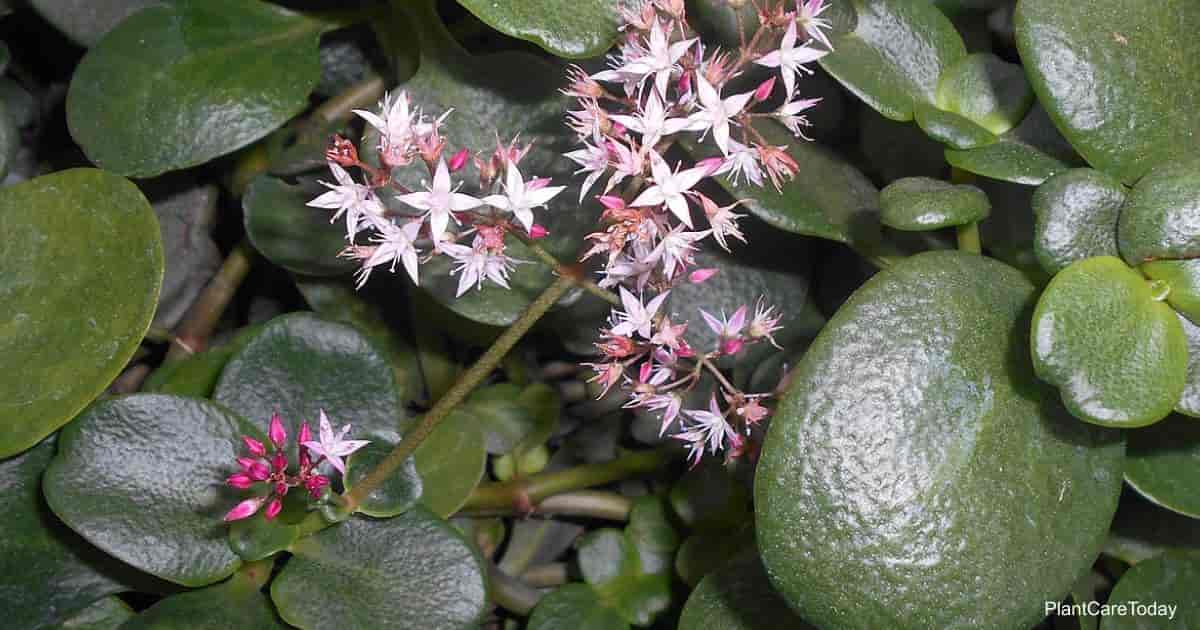Crassula multicava [KRASS-oo-la, mul-tee-KAV-uh] is a member of the family Crassulaceae hailing from South Africa where it is found growing naturally in Natal’s mountainous regions.

Common names include:
- Cape Province Pygmy Weed
- Mosquito Flower
- Pitted Crassula
- Fairy Crassula
- London Pride
The plant’s name, Crassula, comes from the Latin word Crassus, which means thick.
This refers to the plant’s thick leaves.
Its species name, multicava, is a reference to the tiny pits or pores found on the leaves. The name means many caves.
Crassula quadrifida and Septimia multicava are synonyms for Crassula multicava
Crassula Multicava Care
Size & Growth
This perennial, mat-forming succulent is a moderate to fast-growing evergreen groundcover.
Cape Province Pygmy Weed can grow to be about a foot high and presents an attractive appearance when planted in mass as a groundcover.
The Crassula multicava has a glossy round or oval leaves growing in opposing pairs along the stems.

Leaves tend to be lighter colored when the plant grows in the sun and darker when it is placed in a shady setting.
The leaves have small pores along the edges called hydathodes, which allow moisture from the air to be absorbed into the plant.
This is an important way in which these plants attain the moisture they need to survive and thrive.
Some butterfly caterpillars feed on Crassula foliage, so specimen plants can make a nice addition to your pollinator garden.
Flowering & Fragrance
The very small flowers are star-shaped and grow in masses on stems above the pretty leaves. They begin as pink buds and open into white stars.
Mosquito Flower blooms in the wintertime. The tiny, star-shaped flowers are especially attractive to bees and other pollinators.
Light & Temperature
Fairy Crassula is winter hardy in USDA hardiness zones 9B to 11B and does well in full sun or partial shade.
It can tolerate cold temperatures down to 25° degrees Fahrenheit (-4° C).
Watering & Feeding
It is best to deeply water this perennial, succulent plant occasionally and allow the soil to dry completely before watering again.

Soil & Transplanting
Like most succulents, Cape Province Pygmy Weed likes sharply draining soil.
The best time to repot London Pride is when the weather is warm.
Wait until the soil surrounding the plant is completely dry and then remove it from the soil and brush any loose soil from the roots before replanting into the fresh succulent mix.
Grooming & Maintenance
Very little grooming and maintenance are necessary. If Crassula multicava plants become overgrown, you’ll naturally want to trim them back and keep the cuttings to grow new plants.
If you are using Pitted Crassula as a groundcover over a large area, prune it back harshly with hedge clippers.
Before you know it, fresh foliage and flowers will emerge.
It’s best to perform a hard pruning after flowers have bloomed and seeds have set.
How To Propagate Multicava Fairy Crassula
Crassula is easy to propagate using leaf cuttings, root division, or by transplanting offsets.
It’s especially easy to allow the plant to sprout from leaves simply placed on the surface of a dish of succulent potting mix.
Related: Propeller Plant Care (Crassula falcata)
Fairy Crassula Pest or Disease Problems
As with most succulents, these Crassulas can succumb to fungal disease and succulent mealybug pests if they are overwatered, overcrowded, poorly ventilated, or planted in a dark, dank area.

Is The Plant Toxic or Poisonous?
Many members of the Crassulaceae family are toxic.
The fact this plant is used as an emetic (a substance used to induce vomiting) in African folk medicine indicates it should not be casually ingested.
Is This Crassula Plant Invasive?
These easy rooting, free seeding, perennial plants are not endangered in their natural habitat.
In fact, in its native setting, Mosquito Flower spreads quickly and easily through seed dispersal root spread and fallen leaves, which quickly spring roots and grow into independent plants.
Additionally, tiny plantlets may grow on the flower heads, which drop off the plant and grow on their own.
This enthusiastic propagation tendency has caused Crassula multicava to become somewhat invasive in Australia and also in some warm areas in the United States, such as California.
Suggested Crassula Multicava Uses
This drought-tolerant perennial is a good plant for covering rocky slopes, riverbanks, and challenging cliffs.
In Africa, the plant has medicinal uses as an emetic.
Furthermore, its sap is often made into an infusion and sprinkled around homesteads as a way of deflecting lightning.
Crassula multicava does very well in hanging baskets and containers.
It’s also a nice addition to your butterfly garden or rock garden, and it makes a nice planting under oak trees because it’s a good groundcover which does not need a lot of water.
Likewise, it’s a good ground cover under pine trees.
It is not a good idea to use it as a groundcover in high traffic areas as it cannot tolerate being trodden upon.